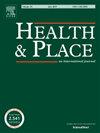Novel indices of state- and county-level social disadvantage in older Americans and disparities in mortality
IF 3.8
2区 医学
Q1 PUBLIC, ENVIRONMENTAL & OCCUPATIONAL HEALTH
引用次数: 0
Abstract
Studying and defining social contextual disadvantage in community-living older persons is vitally important, yet no composite indices of social disadvantage have been developed and validated specifically for the geriatric population. The current study aims to create two novel composite indices representing state- and county-level social contextual disadvantage in older (≥65 years) persons in the United States (US), and to evaluate whether disparities in mortality exist between index-defined disadvantaged and non-disadvantaged groups. Publicly-available state- and county-level (2006–2014) contextual factors from all 50 US states and 3132 counties were used to create indices of social contextual disadvantage. Associations of disadvantage-status with mortality (2010–2019) were assessed by negative binomial models. We found mortality rates were significantly higher in index-defined disadvantaged states/counties compared with non-disadvantaged ones for 2010–2015 and 2014–2019. For both periods, compared with non-disadvantaged states, the disadvantaged states had at least 11% increased mortality risk. At the county-level, the disadvantaged counties had an approximately 10% increased mortality risk. The findings suggest that the two indices of state- and county-level contextual disadvantage in older persons may serve as useful tools for identifying place-based disadvantaged populations of older Americans and as multidimensional factors driving mortality disparities. State- and county-level social contextual disadvantage should be considered when formulating public health policies and interventions aimed at reducing health disparities.
美国老年人的州和县一级社会不利条件新指数及死亡率差异
本文章由计算机程序翻译,如有差异,请以英文原文为准。
求助全文
约1分钟内获得全文
求助全文
来源期刊

Health & Place
PUBLIC, ENVIRONMENTAL & OCCUPATIONAL HEALTH-
CiteScore
7.70
自引率
6.20%
发文量
176
审稿时长
29 days
期刊介绍:
he journal is an interdisciplinary journal dedicated to the study of all aspects of health and health care in which place or location matters.
 求助内容:
求助内容: 应助结果提醒方式:
应助结果提醒方式:


